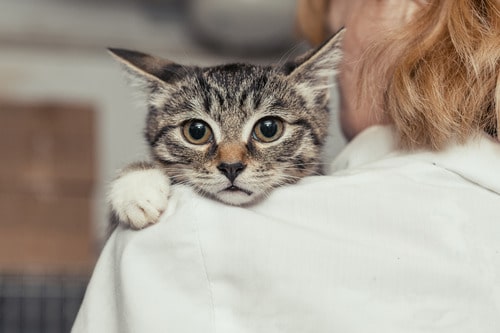Cats are known for their beautiful, soft coats, and petting their fur can bring comfort and joy to you and your feline friend. If you notice patches of hair loss, especially on your cat’s belly, it can be alarming. Hair loss, also called alopecia, is a common issue in cats, and it can occur for a variety of reasons. If your cat is losing hair on its belly, it’s important not to panic and know that your veterinarian can help diagnose and address the issue. At Arrowhead Animal Hospital in Westminster, Colorado, our team is here to help you identify the root cause of your cat’s hair loss. Call (303) 469-1616 or book an appointment online if you notice unusual changes in your cat’s coat or skin.
Why Is My Cat Losing Hair on Its Belly?
Hair loss on a cat’s belly can be caused by a range of underlying issues, from medical conditions to behavioral factors. Below are some of the most common causes.
Allergies
Just like humans, cats can be sensitive to environmental allergens, certain foods, or flea bites. When your cat develops an allergy, it often causes itchy skin, leading to excessive grooming, biting, and scratching. Common types of allergies in cats include:
- Environmental Allergies: Pollen, mold, dust mites, and even cleaning products can trigger reactions in sensitive cats.
- Food Allergies: Some cats develop intolerances to specific proteins, grains, or other ingredients in their food, which may cause inflammation and skin irritation.
- Flea Allergies: Flea bites can cause allergic reactions, even if your cat doesn’t have a visible flea infestation.
If you notice your cat losing hair on its belly while also frequently scratching or licking, it could be a sign of an allergy. Your veterinarian can conduct tests to pinpoint the allergen and recommend changes to manage the condition.
Parasites
Parasites, such as fleas, mites, and ticks can irritate your cat’s skin, leading to overgrooming and bald spots. Even a single flea bite can cause intense itching in cats sensitive to flea saliva.
Mange mites or ear mites can also create severe discomfort and patchy hair loss. Though less common, ticks can attach to your cat’s skin and cause localized irritation. Your veterinarian can perform a thorough examination to determine if parasites are contributing to your cat’s hair loss. Prescription flea and parasite preventatives can effectively resolve the issue.
Stress and Overgrooming
Cats are creatures of habit, and any changes to their environment, routine, or health can lead to stress. When cats feel stressed, they often cope by overgrooming, which can result in hair loss on their belly or other areas. Potential causes of stress or overgrooming may include the following:
- Environmental Changes: Moving homes, introducing new pets, or even rearranging furniture can trigger stress in cats.
- Boredom: Cats that lack stimulation may develop obsessive grooming habits as a form of self-soothing.
- Underlying Pain: In some cases, overgrooming could be linked to pain or discomfort, even if the issue isn’t visible.
If your cat is losing hair on its belly due to overgrooming, your veterinarian can offer guidance on environmental enrichment and potential treatments to reduce anxiety.
Hormonal Imbalances
Hormonal imbalances such as hyperthyroidism, Cushing’s disease, and other endocrine disorders can lead to changes in your cat’s coat and skin health. Hyperthyroidism occurs when the thyroid gland produces too much hormone, leading to weight loss, restlessness, and skin issues, including hair loss. Cushing’s Disease leads to excessive cortisol production which can cause thinning hair, increased thirst, and skin fragility. Hormones also play a critical role in maintaining a healthy coat, and imbalances may disrupt the natural growth cycle of your cat’s fur. Diagnosing hormonal conditions requires specific testing, which your veterinarian can conduct. Proper treatment can help restore your cat’s health and prevent further hair loss.
Skin Infections
Skin infections, both bacterial and fungal, can contribute to hair loss on your cat’s belly. If your cat’s skin is injured or irritated, bacteria can multiply, leading to localized bacterial infections. Ringworm is a common fungal infection that causes circular bald spots, often starting on the belly or legs. Skin infections often present with additional symptoms, such as redness, swelling, or crusty patches. Your veterinarian may recommend topical or oral treatments to resolve the infection and prevent it from spreading.
Diagnosing Hair Loss in Cats
If your cat is losing hair on its belly, visit your veterinarian for a thorough evaluation. The diagnosis process typically includes the following steps:
- Physical Examination: Your vet will examine your cat’s skin, coat, and overall condition.
- Medical History: Your vet will ask about your cat’s diet, behavior, and any recent changes in their environment.
- Testing: Depending on the symptoms, tests may be necessary to determine a cause.
- Imaging: In some cases, imaging may be needed to rule out underlying medical issues contributing to hair loss.
When to See Your Veterinarian for Hair Loss
While occasional shedding is normal, significant or patchy hair loss, particularly on the belly, can indicate an underlying issue that requires veterinary attention. You should schedule a visit if you notice:
- Bald patches or thinning fur
- Excessive grooming, scratching, or biting
- Changes in behavior, such as lethargy or restlessness
- Redness, swelling, or sores on the skin
- Signs of pain or discomfort
How Arrowhead Animal Hospital Can Help
If you’re concerned about your cat losing hair on its belly, the team at Arrowhead Animal Hospital is here to provide professional, compassionate care. We use advanced diagnostic tools to uncover the root of the issue and recommend effective treatment options to help your cat feel its best. Hair loss can be a stressful experience for both you and your cat, but with proper care and attention, most underlying causes can be managed or resolved. Don’t wait to seek help—call us today at (303) 469-1616 or book an appointment online to schedule an evaluation.





